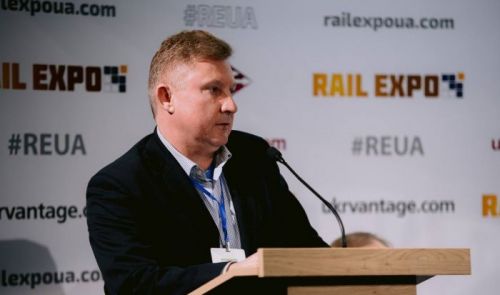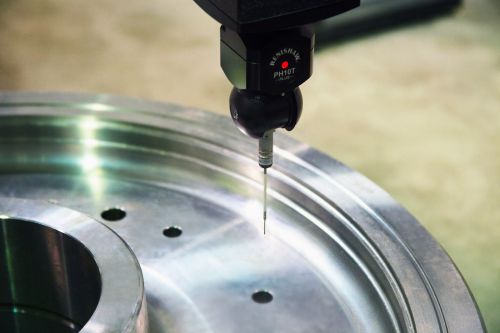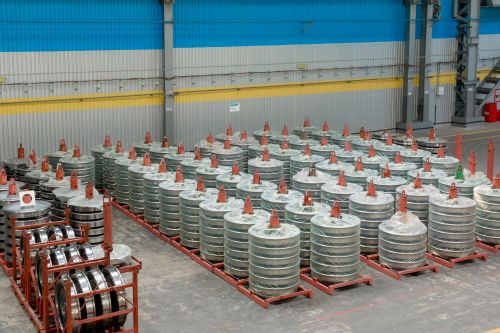In an interview with the CFTS portal, Oleksandr Roslik, Technical Director of the Railway Products Division of the Interpipe Industrial Group, talks about the challenges of producing railway wheels during the war, changes in export logistics, and the prospects of integrating the Ukrainian railway industry into the European Union.
The Russian invasion forced Interpipe to shut down its facilities in February 2022, but production, including the production of railway products, began to gradually recover in April of that year. Nevertheless, the company and its employees faced new challenges: adapting to work under constant enemy attacks and changing export logistics. Nonetheless, within two years the Railway Products Division of the Ukrainian industrial group has launched new product lines both for the EU market and for Ukrzaliznytsia. The company helps its employees who are mobilized for military service, supports civilians, and implements rehabilitation programs for war veterans.
On the sidelines of the VI International Conference "Ukrainian Railways: Development and Investments," the CFTS portal talked to Oleksandr Roslik, Technical Director of the Railway Products Division of the Interpipe Industrial Group, about the challenges of operating during the war and the subsequent expansion into the EU market.
How has the war affected the company's production processes? What changes have been made?
At the very beginning of the full-scale invasion, Interpipe's management decided to completely stop production, especially the production of railway products. The lives and safety of our employees are our top priority. We started to gradually resume production in April 2022.
However, because of constant air-raid alerts and the threat of missile attacks, our employees are forced to go into bomb shelters. This affects economic performance: the complex technological equipment used in production processes cannot be switched off at the touch of a button during an air raid alert without wasting energy or raw materials.
Another challenge for us was to maintain operations in the face of severe power supply restrictions in late 2022 and early 2023. We planned production to ensure that the most energy-intensive equipment operated at night, avoiding peak hours in the morning and evening.
How has the export logistics of railway products changed in the past two years?
Some routes have become 1.5 times longer. In general, the volume of export orders naturally decreased after the invasion. However, alternative supply routes have been established thanks to the clear actions of Interpipe's logisticians and our partners. A wide range of technical and commercial issues were agreed upon, interaction with new logistics terminals was established, new connections and relationships were created, and IT systems were rebuilt for the new tasks and requirements. Thanks to this, Interpipe had stable and generally manageable logistics in 2023.
In mid-2022, Interpipe announced it had launched the production of a new type of wheel for the EU market. Has the company had any other such interesting cases in the past two years? Do you have any plans to enter new markets or launch new products?
As far as new products for export are concerned, Interpipe's R&D experts launched 24 new wheel and axle sizes in 2023. We are currently working on starting the production of wheelsets with disc brakes for foreign customers.
As for the domestic market, we are ready to offer Ukrzaliznytsia wheel centers, finished axles, and assembled wheelsets, as well as wheels for General Electric locomotives and Hyundai and Škoda trains.
What is happening with the modernization of Ukrzaliznytsia's rolling stock? What is the current level of the railway monopoly's demand for wheel products?
Unfortunately, Ukraine is currently forced to spend a significant part of its budget on defending its sovereignty, territory, and people's lives. Therefore, the demand for wheel products has decreased. However, despite the martial law in the country, in 2023 our company started the production of wheels of two new standard sizes for special self-propelled vehicles and manufactured them for Ukrzaliznytsia. We produced about 350 wheels of these new standard sizes, which fully covered the needs of Ukrzaliznytsia. This also solved the problem of import substitution: before the war, Russian manufacturers used to produce wheels of this design for Ukrzaliznytsia.
We have produced about 350 wheels of new standard sizes, which fully cover the needs of Ukrzaliznytsia. This also solves the problem of import substitution: before the war, Russian manufacturers used to produce wheels of this design for Ukrzaliznytsia.
The railway infrastructure in Ukraine has a high level of wear and tear. How does this affect the wear-out periods of rolling stock wheels?
Not only the wear and tear of infrastructure but also the wear and tear of the rolling stock systems affect the service life of the wheels. Malfunctions of a railcar's braking system and track switches and inconsistency of the track profile in curves (especially small-radius curves) can all result in the need to regrind (re-profile) a wheel, and every re-profiling reduces the life of a wheel because there is a limit to the rim thickness that is safe for operation.
For example, increased gaps in the joints between the rails, where the car "jumps," create some additional loads in the rim of the wheel, but such cases are taken into account by the technical requirements for wheels, in particular, by the mechanical indicators specified both in the Ukrainian and European wheel standards.
By the way, the hypothetical accession of Ukraine to the European Union implies the implementation of several systemic reforms and adaptation to European standards, especially railway industry standards. How is Interpipe preparing for this?
It is safe to say that the European market is Interpipe's home market. The company traditionally supplies its railway products to the European Union. In Europe, two out of three freight cars have Interpipe wheels. Over two decades, we have mastered the production of over 250 new sizes of wheels, axles, and wheelsets, including for high-speed passenger trains.
In other words, we have extensive experience in developing new designs for European customers and in accordance with EU standards. They are stricter than Ukrainian standards. Therefore, the transition to the production of railway products in accordance with European standards will improve traffic safety in Ukraine. In turn, stricter operational requirements will increase the travel speed and service life of railway products. We are ready to share our experience with Ukrainian operators and manufacturers, and we are ready to supply to Ukraine in accordance with European standards.
In general, the integration of the railways of Ukraine and the European Union will ensure, first, the unification of rolling stock and, second, the unification of infrastructure, followed by the free movement of rolling stock on the territory of both the European Union and Ukraine.
Do you think that Ukrainian railcar manufacturers are ready to produce rolling stock to EU standards? Which components will be imported?
This is a question for our railcar manufacturers. However, we heard from their representatives at the conference that Ukrainian railcar manufacturers already have proposals for the European market.
Regarding the import of components, Ukraine has traditionally had a strong railcar manufacturing industry. A freight car is almost 100% made of Ukrainian components. As for passenger railcars, imported components traditionally account for at least one-third.
European standards are stricter than the current Ukrainian standards. Therefore, it is very important that all wheel suppliers comply with these standards during production. This will ensure a higher level of railway safety.
Integration into the European Union means tougher competition with European wheel manufacturers. Is Interpipe ready for this?
Interpipe has been present in the European railway market for a long time, competing with local producers and doing so quite successfully. So, I do not see any problems. As for the Ukrainian railway wheel market, it has never been closed. There have never been restrictions in the form of duties or quotas. Even now, any supplier can come to Ukraine and compete.
However, as I said, the European standards are stricter than the current Ukrainian standards. Therefore, it is very important that all wheel suppliers comply with these standards in their production. This, in turn, will ensure a higher level of railway safety, improved reliability of rolling stock operation, and prolongation of the service life of rolling stock.
How will the creation of the Ukrainian national platform "Made in Ukraine" affect the railcar manufacturing industry?
We hope it will be positive. After all, maintaining domestic industrial production primarily means ensuring employment and timely payment of wages, especially in the frontline regions. This, in turn, means timely tax revenues for local budgets.
In addition, the production of goods for export ensures that Ukraine earns scarce foreign currency, which helps to stabilize and maintain the national currency.
It also enables private companies to shoulder a significant social burden: helping our employees mobilized for military service and supporting the military with ammunition, medicines, and other necessities; assisting civilians, for example, in rebuilding homes damaged by enemy shelling; and rehabilitating and reintegrating veterans into civilian life.






